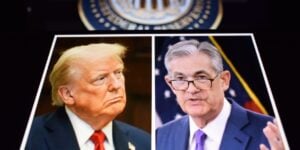
Regulating risk and thereby preventing another financial crisis has been the objective of macroprudential regulation by the Federal Reserve since the financial crisis of 2007-8. The Dodd-Frank Act, signed into law in 2010, mandated that the Federal Reserve Board and other financial regulatory agencies reduce the risk of a financial crisis such as the one in 2007 and 2008. This regulation involves the Federal Reserve in assessments of whether firms’ activities are prudent in a wide variety of markets with different risk.
Macroprudential regulation is regulation of banks and other firms to prevent them from taking actions which pose a risk to the economy, even if the activity is not a risk to the institutions themselves. An underlying premise is that financial institutions will take risks that can result in a financial crisis and that the Federal Reserve and other regulators can discern the risk of a financial crisis and can prevent banks from taking those risks.
This task is effectively impossible. It is similar in some respects to the general problem of socialist calculation. A central authority or planner cannot know everything that is known to the individual participants in markets. Furthermore, financial crises have certain similarities, but the differences probably are at least as important as the similarities. The risk regulator is in danger of fighting the last war: averting the conditions that led to the last financial crisis but doing nothing to prevent the conditions for the next financial crisis.
A recent development illustrates the problem with such risk regulation.
Risks associated with leveraged loans have been in the news recently. The term “leveraged loans” does not have a precise, commonly agreed definition. Generally speaking, leveraged loans are loans to highly leveraged firms and loans to firms with low credit ratings, although other criteria also are used. In short, leveraged loans are riskier than typical loans. They are similar to subprime mortgage loans — mortgage loans to households with a low credit rating, a bad credit history, or both — which were an important factor in the financial crisis of 2007-8. These loans often are securitized as financial instruments, namely collateralized loan obligations (CLOs).
The Federal Reserve Board has some concern that leveraged loans have been growing too rapidly recently. This concern echoes that of an international organization, the Financial Stability Board. The Financial Stability Board is chaired by Richard Quarles, who is vice chair for supervision on the board. The Financial Stability Board is an international organization concerned, as the name suggests, with financial stability. It recently issued a report on the leveraged-loan market. Indicative of what can be concluded, the summary (2¼ pages long) includes “may” four times, “might” one time, and “could” seven times.
The summary can itself by summarized by selected sentences:
[Leveraged-loan markets] may be more vulnerable to macroeconomic shocks than in the past, and stress in leveraged loan markets could disrupt other markets.… While banks are more resilient to these risks due to higher levels of capital and liquidity as the result of post-crisis reforms, the degree of bank resilience against downturns may be difficult to judge.… Stress episodes could … have negative implications for insurers, pension funds and other non-banks with CLO exposures. … The FSB will consider whether there is scope to close data gaps, will continue to analyse the financial stability risks and will discuss the regulatory and supervisory implications associated with leveraged loans and CLOs.
The FSB report itself says: “A comprehensive assessment of the system-wide implications of the exposures of financial institutions to leveraged loans and CLOs is challenging.”
Is it possible that leveraged loans could be associated with a financial crisis? The answer to this almost surely is yes.
The more important question for regulation: Is it possible to know what regulation or regulations of leveraged loans can reduce the risk of a financial crisis? More precisely, is it possible to assess the likely benefits of regulation in reducing the probability of a financial crisis and to decide on the proper course?
The answer to this is no. First, estimates of how leveraged loans could lead to a crisis would have to be developed. It is difficult to conceive of having a very precise estimate of this. The recent financial crisis unfolded in a way that few if any expected, and there is no evidence those few souls who expected the last financial crisis (1) were in the regulatory community or (2) have superior ability in predicting other financial crises.
For an economist, even if not most other people, another question bedevils such regulation. It is easy to see how to reduce the risk of a financial crisis associated with leveraged loans: prohibit them. The reason for not doing this, of course, is that leveraged loans and many other financial instruments and markets have benefits to participants and to the U.S. economy at large.
How big are those benefits? No one knows. How big are the costs of various possible regulations applied to leveraged loans? No one knows. The balancing act of simply regulating leveraged loans requires knowledge that simply is not available to the Federal Reserve Board with the precision necessary to do anything that is likely to be helpful.




